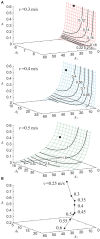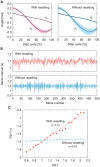Contribution of Phase Resetting to Statistical Persistence in Stride Intervals: A Modeling Study
- PMID: 35814485
- PMCID: PMC9257880
- DOI: 10.3389/fncir.2022.836121
Contribution of Phase Resetting to Statistical Persistence in Stride Intervals: A Modeling Study
Abstract
Stride intervals in human walking fluctuate from one stride to the next, exhibiting statistical persistence. This statistical property is changed by aging, neural disorders, and experimental interventions. It has been hypothesized that the central nervous system is responsible for the statistical persistence. Human walking is a complex phenomenon generated through the dynamic interactions between the central nervous system and the biomechanical system. It has also been hypothesized that the statistical persistence emerges through the dynamic interactions during walking. In particular, a previous study integrated a biomechanical model composed of seven rigid links with a central pattern generator (CPG) model, which incorporated a phase resetting mechanism as sensory feedback as well as feedforward, trajectory tracking, and intermittent feedback controllers, and suggested that phase resetting contributes to the statistical persistence in stride intervals. However, the essential mechanisms remain largely unclear due to the complexity of the neuromechanical model. In this study, we reproduced the statistical persistence in stride intervals using a simplified neuromechanical model composed of a simple compass-type biomechanical model and a simple CPG model that incorporates only phase resetting and a feedforward controller. A lack of phase resetting induced a loss of statistical persistence, as observed for aging, neural disorders, and experimental interventions. These mechanisms were clarified based on the phase response characteristics of our model. These findings provide useful insight into the mechanisms responsible for the statistical persistence of stride intervals in human walking.
Keywords: central pattern generator; human walking; neuromechanical model; phase resetting; statistical persistence; stride interval fluctuation.
Copyright © 2022 Okamoto, Obayashi, Kokubu, Senda, Tsuchiya and Aoi.
Conflict of interest statement
The authors declare that the research was conducted in the absence of any commercial or financial relationships that could be construed as a potential conflict of interest. The reviewer TN declared a shared affiliation with the author SA to the handling editor at time of review.
Figures







Similar articles
-
Phase resetting and intermittent control at the edge of stability in a simple biped model generates 1/f-like gait cycle variability.Biol Cybern. 2020 Feb;114(1):95-111. doi: 10.1007/s00422-020-00816-y. Epub 2020 Jan 20. Biol Cybern. 2020. PMID: 31960137
-
Contribution of Phase Resetting to Adaptive Rhythm Control in Human Walking Based on the Phase Response Curves of a Neuromusculoskeletal Model.Front Neurosci. 2020 Feb 5;14:17. doi: 10.3389/fnins.2020.00017. eCollection 2020. Front Neurosci. 2020. PMID: 32116492 Free PMC article.
-
Evaluating functional roles of phase resetting in generation of adaptive human bipedal walking with a physiologically based model of the spinal pattern generator.Biol Cybern. 2010 May;102(5):373-87. doi: 10.1007/s00422-010-0373-y. Epub 2010 Mar 9. Biol Cybern. 2010. PMID: 20217427
-
Introducing Statistical Persistence Decay: A Quantification of Stride-to-Stride Time Interval Dependency in Human Gait.Ann Biomed Eng. 2018 Jan;46(1):60-70. doi: 10.1007/s10439-017-1934-1. Epub 2017 Sep 25. Ann Biomed Eng. 2018. PMID: 28948419 Free PMC article.
-
Phase resetting behavior in human gait is influenced by treadmill walking speed.Gait Posture. 2016 Jan;43:187-91. doi: 10.1016/j.gaitpost.2015.09.021. Epub 2015 Oct 21. Gait Posture. 2016. PMID: 26475759 Free PMC article.
Cited by
-
Smartphone usage during walking decreases the positive persistency in gait cycle variability.Sci Rep. 2024 Jul 16;14(1):16410. doi: 10.1038/s41598-024-66727-1. Sci Rep. 2024. PMID: 39013927 Free PMC article.
References
-
- Ashkenazy Y., Hausdorff J. M., Ivanov P. C., Stanley H. E. (2002). A stochastic model of human gait dynamics. Phys. A 316, 662–670. 10.1016/S0378-4371(02)01453-X - DOI
Publication types
MeSH terms
LinkOut - more resources
Full Text Sources

